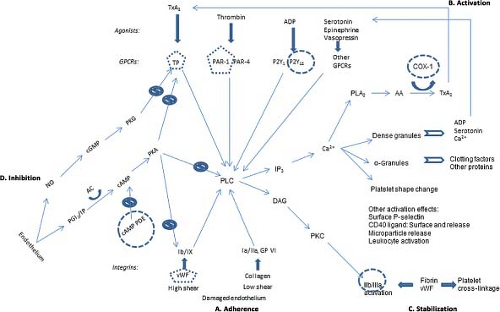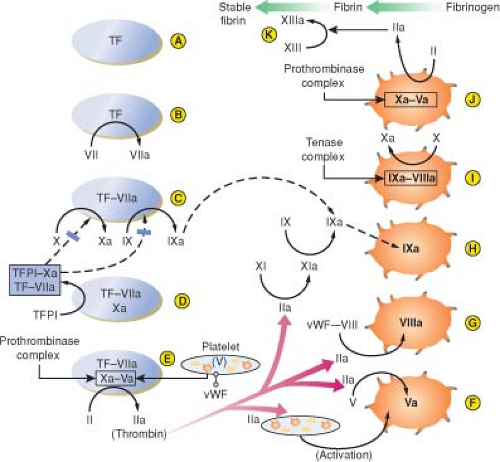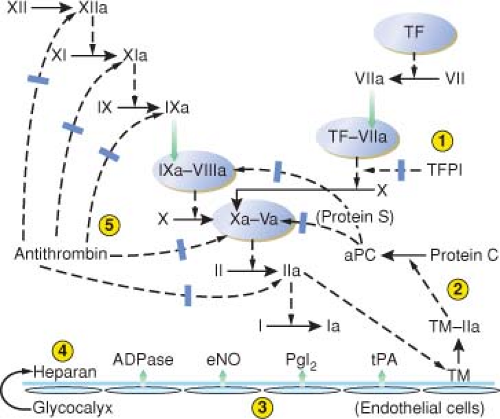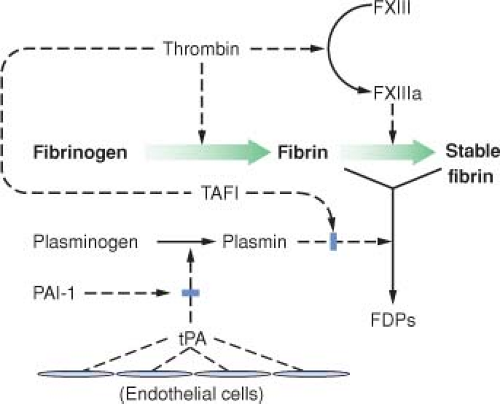Hemostasis and Transfusion Medicine
Perioperative blood component therapy accounts for at least 23% of all blood product transfusions (Carabini LM, Ramsey G. Hemostasis and transfusion medicine. In: Barash PG, Cullen BF, Stoelting RK, Cahalan MK, Ortega R, Stock MC, eds. Clinical Anesthesia. Philadelphia: Lippincott Williams & Wilkins; 2013:408–444). It is imperative for anesthesia professionals to understand the treatment benefits, the rare and common adverse effects, and the specific therapeutic details of blood product preparation and delivery to best manage their patients.
I. Hemostasis and Coagulation
Primary Hemostasis. The delicate equilibrium between anticoagulation and coagulation is maintained by a complex system of counterbalanced blood proteins and cells (platelets). Many congenital and acquired disorders can push the system toward either bleeding or thrombosis. A number of tests can be used to evaluate the system and therapeutic modalities to correct these imbalances.
Platelets adhere to sites of endothelial disruption; undergo activation to recruit more platelets and amplify the platelet response; and then crosslink with fibrin, the end product of the plasma clotting factor cascade, to form a platelet plug (Fig. 16-1).
To maintain hemostatic balance, platelets are naturally inhibited in their endothelial environment.
Secondary Hemostasis. Clotting factors in the plasma are activated at sites of endothelial injury and assemble in enzymatic complexes to activate thrombin.
The extrinsic pathway begins when endothelial disruption exposes tissue factor on underlying cell membranes, extrinsic to the circulation (Fig. 16-2A–E).
The intrinsic pathway involves thrombin that has several central functions (Fig. 16-2F–J).
Clotting factors are primarily produced in the liver, except for VIII, which also is released by endothelial cells and is well maintained in liver disease.
The plasma half-life of most clotting factors is around 1.5 to 3 days, but those of the factor VII (6 hours) and the cofactors V and VIII (8–12 hours) are much shorter.
Inhibition of Clotting Factors (Fig. 16-3).
II. Fibrinolysis
III. Laboratory Evaluation of Hemostasis
The first screening test for hemostatic problems should always be the patient’s medical history (Table 16-1).
Table 16-1 Medical History as Secreeing test for Hemostatic Problems | |||
|---|---|---|---|
|
IV. Laboratory Evaluation of Primary Hemostasis
The normal automated platelet count in adults is approximately 150,000 to 400,000/μL. The peripheral blood smear should be examined in specimens with abnormal platelet counts or size. Platelet aggregation is the most detailed overall platelet function test.
Von Willebrand disease (vWD) is a factor deficiency that imparts clinical features of platelet dysfunction because of the central role of von Willebrand factor (vWF) in cross-linking activated platelets to form the platelet plug. Initial testing for vWD should include the vWF antigen level, vWF activity level, and a factor VIII activity level for comparison with vWF.
V. Laboratory Evaluation of Secondary Hemostasis and Coagulation
A general oversight of plasma clotting factor activity is obtained by the prothrombin time (PT) for the intrinsic (tissue) pathway and the activated partial thromboplastin time (aPTT) for the extrinsic (contact) pathway with both tests completed through the common pathway (see Fig. 16-1).
Representative normal ranges are around 12 to 15 seconds for the PT and 25 to 35 seconds for the aPTT but are defined by each laboratory using its own equipment, reagents, and normal specimens. Testing is routinely performed at 37°C, but hypothermia in a patient impairs the enzymatic reactions of clot formation.
Most assays measure the functional conversion of fibrinogen to fibrin, although the fibrinogen protein level also can be measured for comparison to assess fibrinogen dysfunction. Normal fibrinogen levels are around 150 to 400 mg/dL.
Mixing Studies. To investigate unexpectedly elevated PT or aPTT values, the test should be repeated after mixing the patient’s plasma with equal volumes of normal plasma.
In severe factor deficiencies, PT or aPTT shows substantial correction toward normal in a mixing study.
If the patient’s plasma contains an inhibitor or an anticoagulant, the normal plasma will also be affected, and PT or aPTT will not correct.
Individual factor-level activities are determined by the degree of correction that patient plasma gives when mixed with factor-deficient plasma.
Coagulation inhibitors are substances, usually antibodies, that block one or more clotting factors.
Disseminated intravascular coagulation (DIC) is unchecked coagulation initiated by pathologic systemic activation of the intrinsic clotting pathway.
Other tests that are commonly performed during surgery with whole-blood specimens are the activated clotting time (ACT), ecarin clotting time (ECT), and viscoelastic whole-blood clotting with thromboelastography.
The ACT is a point of care test that assesses the intrinsic clotting pathway and is used mainly to monitor heparin anticoagulation and its protamine reversal during cardiopulmonary bypass or vascular surgery.
Whole-blood clotting and fibrinolysis can be assessed by viscoelastic testing in thromboelastography.
VI. Diagnosis of Thromboembolic Disorders
The risk for deep vein thrombosis (DVT) is increased by intercurrent factors such as physical inactivity or immobilization, malignancy, oral contraceptives, estrogen therapy, and pregnancy.
Congenital Risk Factors for Thrombosis
Congenital problems are mostly categorized as deficiencies in antithrombotic pathways or hypercoagulable clotting factors.
Several congenital factors involve the protein C-ase complex and its function. Protein C itself is functionally deficient in up to 0.5% of the population, with autosomal
dominant inheritance. This leads to overactive factor VIII and factor V cofactors in their respective intrinsic tenase and prothrombinase complexes.
Acquired Risk Factors for Thrombosis (Table 16-2)
Table 16-2 Acquired Risk Factors for Thrombosis | ||
|---|---|---|
|
VII. Monigtoring Anticoagulation Therapeutic Agents
Most anticoagulant therapies need ongoing or selective testing for assessment of therapeutic effect. Appropriate monitoring ensures that these agents are maintained within the therapeutic range; otherwise patients are at risk of thromboembolism and bleeding complications.
Warfarin Anticoagulation. Warfarin therapy must be monitored by the PT and its analogue for this purpose, the international normalized ratio (INR), to avoid under- or overcoagulation.
PT methods and reagents can widely differ between laboratories, yielding varying PT values for the same degree of factor deficiency.
The INR is a normalized value that is intended to compare results across laboratories
Heparin Anticoagulation Testing. The aPTT is used to assess heparin anticoagulation. Each laboratory determines its own therapeutic target range for heparin anticoagulation, typically on the order of 1.5 to 2.5 times the normal mean.
Low-molecular-weight heparin (LMWH) drugs and their analogue, synthetic pentasaccharide (fondaparinux), do not affect the aPTT assay, and coagulation testing is usually not needed.
Heparin and to a lesser degree LMWH can stimulate the production of antibodies against the heparin-platelet factor 4 complex. These antibodies can in turn cause heparin-induced thrombocytopenia (HIT) or activation of platelets to induce thrombosis.
Newer anticoagulants (alternatives to heparin in patients with HIT and to patients being treated with warfarin) are direct anticoagulants (rivaroxaban, apixaban) that are not mediated by antithrombin. They prolong the PT and aPTT, but monitoring is not recommended, and the INR should not be used.
Direct thrombin inhibitors (DTIs) prolong the PT and aPTT and interfere with clot-based fibrinogen assays.
VIII. Blood Component Production
Blood Collection (Table 16-3). The production of blood components is highly controlled by regulations and accreditation requirements in the interests of donor and recipient safety and therapeutic efficacy. Blood donors are carefully screened and tested, and blood products are made in specialized laboratories and other facilities.
Component Processing and Storage
Leukoreduction to remove white blood cells from red blood cells (RBCs) and platelets reduces the risk of human leukocyte antigen alloimmunization, febrile nonhemolytic transfusion reactions, and cytomegalovirus (CMV) transmission in patients who require these precautions.
Washing cellular components with saline is mostly done to remove plasma in patients with allergic transfusion reactions such as those who are immunoglobulin A deficient.
Irradiation of cellular components is performed to prevent transfusion graft-versus-host disease (GVHD) from directed-donor units from blood relatives and in highly immunosuppressed patients (those with leukemia, lymphoma, hematopoietic stem cell transplants, or congenital cellular immunodeficiencies) at risk for this complication.
Platelets are stored at room temperature to preserve clotting function, but this increases the risk of bacterial growth in contaminated units compared with other blood components.
RBC preservation solutions use CDPA (citrate for anticoagulation, phosphate as a buffer, adenine, and 1–2 g of dextrose to maintain adenosine triphosphate levels and RBC membrane integrity).
Plasma derivatives (albumin, immunoglobulins, clotting factors) are proteins processed from plasma for therapeutic infusions.
Albumin is produced in large quantities for intravascular volume support and is pasteurized at 60°C for sterility.
Immunoglobulins (Igs) are given for immune support or for immunomodulation to suppress native antibody production.
Table 16-3 Blood Components | ||||||||||||||||||||||||
|---|---|---|---|---|---|---|---|---|---|---|---|---|---|---|---|---|---|---|---|---|---|---|---|---|
|
IX. Blood Products and Transfusion Thresholds
Compatibility Testing
Routine RBC compatibility testing includes ABO and RhD typing, an antibody screen for IgG non-ABO RBC antibodies, and a RBC crossmatch.
RBCs must be ABO compatible to avoid intravascular hemolysis, and Rh D-negative patients should receive D-negative RBCs to avoid anti-D alloimmunization.
Rh, Kell, Kidd, Duffy, and some other non-ABO antibodies can hemolyze transfused RBCs; 1% of all patients and 5% to 20% of heavily transfused patients have such antibodies.
Red Blood Cells
The American Society for Anesthesiologists’ Practice Guidelines for Blood Component Therapy
Full access? Get Clinical Tree












